
Amiens is a city and commune in northern France, located 120 km (75 mi) north of Paris and 100 km (62 mi) south-west of Lille. It is the capital of the Somme department in the region of Hauts-de-France and had a population of 135,429, as of 2021. A central landmark of the city is Amiens Cathedral, the largest Gothic cathedral in France. Amiens also has one of the largest university hospitals in France, with a capacity of 1,200 beds. The author Jules Verne lived in Amiens from 1871 until his death in 1905, and served on the city council for 15 years. Amiens is the birthplace of French president Emmanuel Macron.

Albi is a commune in southern France. It is the prefecture of the Tarn department, on the river Tarn, 85 km northeast of Toulouse. Its inhabitants are called Albigensians. It is the seat of the Archbishop of Albi.

Lyon, traditionally spelled in English as Lyons, is the third-largest city of France. It is located at the confluence of the rivers Rhône and Saône, to the northwest of the French Alps, 391 km (243 mi) southeast of Paris, 278 km (173 mi) north of Marseille, 113 km (70 mi) southwest of Geneva, 58 km (36 mi) northeast of Saint-Étienne.

The Vieux Lyon is the largest Renaissance district of Lyon. In 1964, Vieux-Lyon, the city's oldest district, became the first site in France to be protected under the Malraux law to protect France's cultural sites. Covering an area of 424 hectares between the Fourvière hill and the river Saône, it is one of Europe's most extensive Renaissance neighborhoods. There are three distinct sections: Saint Jean, Saint Paul and Saint Georges. In 1998, Vieux Lyon was inscribed on the UNESCO World Heritage List along with other districts in Lyon because of its historical importance and architecture.
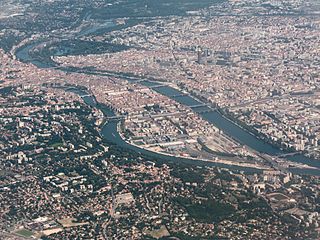
The Presqu'île is the central part of the City of Lyon, France. Extending from the foot of the Croix-Rousse hill in the north to the confluence of the Rhône and the Saône rivers in the south, it has a preponderance of cafés, restaurants, luxury shops, department stores, banks, government buildings and cultural institutions.

The 5th arrondissement of Lyon is one of the nine arrondissements of the City of Lyon, France.
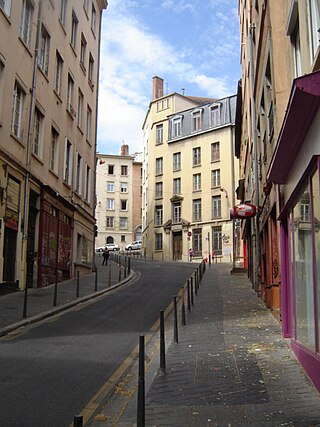
The Montée des Carmélites is one of the oldest streets of Lyon, dating from Roman times, located in the 1st arrondissement of Lyon. It connects the Saint-Vincent quarter to the Plateau de la Croix-Rousse. It is situated between the rue de la Tourette and the rue Ray Fernand, and ends at the intersection of the rue Burdeau, rue du Jardin des Plantes and rue de l'Annonciade.

The Rue Lainerie is an ancient cobbled pedestrian street of the Vieux Lyon quarter, in the 5th arrondissement of Lyon. From north to south, it connects two quarters, Saint-Paul and Saint-Jean, and more precisely the Place du Change and the Place Saint-Paul. There is currently an academy of music at No. 1 and many hotels. The street is served by many buses (29-30-31-44-184), two metro stations and a velo'v station. It belongs to the zone classified as World Heritage Site by UNESCO.
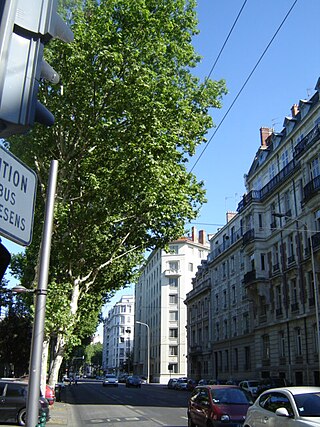
The Boulevard des Belges is a wide and posh avenue located in Les Brotteaux quarter, in the 6th arrondissement of Lyon. It begins with the Quai de Grande Bretagne, runs along the southern part of the Parc de la Tête d'Or until the Avenue Verguin and ends on the Place Jules Ferry, in front of the Gare des Brotteaux. The boulevard is lined with plane trees and is served by two velo'v stations and the line B of the metro.

The Rue du Bœuf is a 188-metre cobbled pedestrian street of the Vieux Lyon quarter, located in the 5th arrondissement of Lyon. Very representative of the Renaissance architecture of the neighborhood, it is lined only with old houses from the 16th or 17th century. The street connects the rue de Gadagne which it continues after the Place du Petit Collège and the intersection of the rue du Chemin Neuf, the rue de la Bombarde and the rue Tramassac which prolongs it. The street belongs to the zone classified as World Heritage Site by UNESCO.

The Place Benoît-Crépu is a stone-paved square, located in Saint-Georges quarter, on the banks of the Saône, in the 5th arrondissement of Lyon. It has fountains with dolphin heads, many benches and trees and a playground. The place belongs to the area classified as World Heritage Site by UNESCO.

The Rue de Gadagne is a paved pedestrian street of the Saint-Jean quarter, in the 5th arrondissement of Lyon. It extends the rue du Bœuf and ends on the rue Lainerie that leads itself to the Place Saint-Paul. It is located in the center of Vieux Lyon and is part to the area which includes a mosaic of squares : Place du Change, Place du Petit Collège and Place de la Baleine in the extension of rue Saint-Jean. The street belongs to the zone classified as World Heritage Site by UNESCO. It is served by buses 29-30-31-44-184, a metro station and three velo'v stations.

The Église Saint-Georges is a Roman Catholic church located on the Place François-Bertras, in the Vieux Lyon quarter, in the 5th arrondissement of Lyon. It is under the direction of the Primatiale parish and was named in honor of Saint George. The cathedral is near the Place Benoît-Crépu, between the quarter of the Quarantaine and Saint-Jean quarters.
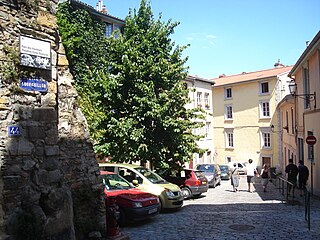
The Montée du Gourguillon is an old street in the 5th arrondissement of Lyon, France, on the hill of Fourvière, between the Saint-Jean and Saint-Just quarters. Montée translates in English to the nouns "climb" or "rise " and is given to a number of steep streets. The ancient Roman settlement of Lugdunum was established here in 43 BC. The montée du Gourguillon begins at the Place de la Trinité and ascends to the rue des Farges. Fourvière is known as "the hill that prays" because the Basilica of Notre-Dame de Fourvière, several convents, and the Archbishop's residence are located there. The street belongs to a zone classified by UNESCO as a World Heritage Site.

The Église Saint-Paul is a Roman Catholic church located in Lyon, France. It is situated in the Vieux Lyon, in the Saint-Paul quarter, in the 5th arrondissement of Lyon. The cathedral is in the Romanesque and Gothic architectural styles. The tower-lantern was classified as monument historique in 1920, and the whole church was classified in 1996. In 2002, the church was completely renovated. It is around 45 m long and 16.5 m high under the arch.

The Manécanterie is an ancient monument situated in Lyon in Saint Jean district, in the 5th arrondissement of Lyon. It is placed side by side to the south southwest of the cathedral Saint Jean and is a part of the former convent of the cathedral. This small Romanesque building served first as dining hall to the canons of Saint Jean, before becoming a parish choir school, namely a school for the singing of the clergy. In 1998, it was inscribed on the UNESCO World Heritage List along with other notable buildings in historic Lyon as a testimony to Lyon's long history and unique architecture.
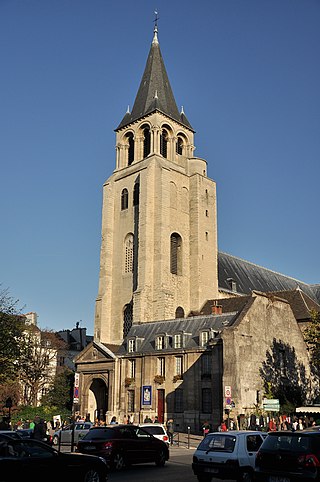
The city of Paris has notable examples of architecture of every period, from the Middle Ages to the 21st century. It was the birthplace of the Gothic style, and has important monuments of the French Renaissance, Classical revival, the Flamboyant style of the reign of Napoleon III, the Belle Époque, and the Art Nouveau style. The great Exposition Universelle (1889) and 1900 added Paris landmarks, including the Eiffel Tower and Grand Palais. In the 20th century, the Art Deco style of architecture first appeared in Paris, and Paris architects also influenced the postmodern architecture of the second half of the century.

Parc des Hauteurs is an urban park on Fourvière hill in Lyon, France. It encompasses the public spaces between the basilique de Fourvière and Loyasse cemetery.

The Church of Saint-Ouen-le-Vieux or the Church of Vieux-Saint-Ouen is a Roman Catholic church dedicated to St. Ouen and located in Saint-Ouen-sur-Seine in the department of Seine-Saint-Denis, France. It was listed as a Historic Monument in 1933.

In the 16th century, the Renaissance, which called for a return to the models of Roman antiquity, spread throughout Europe from Italy, notably through treatises and engravings referring to the treatise De architectura by Vitruvius, Roman theorist of ancient architecture. Each center of culture and creation reinterpreted these new references according to its local traditions.





















